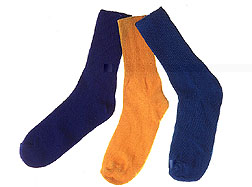300 dpi: (k7254-11.jpg)
640 pixels wide: (k7254-11.jpg)
 Image Number K7254-11 |
Cotton-shoppers find it in the socks and underwear section, not to mention where cloth diapers and first-aid products are sold. And why not? It's often the fabric of choice, and it's being improved all the time.
Cotton has its problems, though-including safety problems like flammability. It was ARS scientists who conducted the initial work on flame-retardant finishes. In 1953, a chemist came up with THPC, a compound that prevented cotton fabrics from flaring up when held in a flame-instead they formed a tough black char. Unlike many other chemicals tested for flame retardancy, THPC survived laundering and dry-cleaning. It was first used in military combat clothing, firemen's uniforms, and hospital linens. but in a short time, flame-resistant finishes, which underwent many improvements, were applied to children's nightwear and many products. Still used today in an improved form, THPC has proved safe, effective, and nontoxic.
Does the thought of socks and underwear conjure up concerns about bacteria? Yes, microbes can reside and multiply in textile fabrics. But no matter-ARS researchers have developed treatments for cotton textiles with compounds containing peroxides. they resist bacteria and, as a bonus, resist fungi that cause athlete's foot.
When medics during World War II pleaded for self-clinging elastic bandages, stretch cottons were born. After the war, consumers asked us to make stretch cotton available in diapers, socks and underwear. Within a matter of years, ARS chemists had invented three different ways to put more stretch into cotton.
After that, ARS helped unchain Americans from the ironing board. First our scientists brought forth wash-and-wear cotton shirts. Then we improved the process by which durable-press cotton fabric finish was created to pose no health risk to textile workers-our new way to cross-link cotton fibers used citric acid to do the trick. The improved process, which has been patented, keeps cotton fabrics wrinkle-free for more than 100 washings.
Today, everyone adores those zany designs that transfer onto cotton tee-shirts. But that iron-on heat transfer process, performed right before your eyes at the beach or boardwalk, wouldn't work on cotton-the transfer's disperse dye, which vaporizes when heated, has an affinity for polyester alone. Researchers have figured out a way to modify the cotton-so now our favorite cartoons and silly slogans "take" with ease.
Photo by Scott Bauer.
